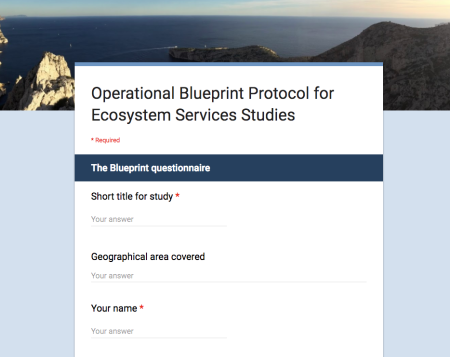
Resource description:
Welcome to the Blueprint protocol for ecosystem services studies. The aims of the protocol are twofold:
- to act as a thinking tool, at the onset of projects, to help researchers design their studies
- to synthesise complex research projects into a common framework.
Hence, it is more than a questionnaire: it can serve as a modus operandi protocol for the design of ES studies, but also for standardizing the comparison, evaluation and the synthesis of ES studies, their operationalisation and their impacts.
Author/Contact:
Dr. Genevieve Patenaude
genevieve.patenaude@ed.ac.uk
The University of Edinburgh
Advantages:
- Support study design
- Help study synthesis
- Enables intercomparisons
Uses of this resource:
Standardised protocol are needed in Ecosystem Service (ES) science to (adapted from Seppelt et al. 2012):
1. Reveal methodological aspects of each studies; this is important for the overall interpretation of results as well as for effective replication .
2. Support robustness and reliability of assessments. This is vital if we are to promote ES as an effective solution for sustainable land and sea management. Successful operationalisation of ES hinges on a strong evidence base for policy formulation and management prescriptions.
3. Structure new assessment studies and monitoring programs. According to the feedback, the BP has already helped refine study designs and it provides a tick-list of essential methodological criteria that may have otherwise been overlooked.
4. Provide a base for comparing and synthesising the results from the ES studies. This is critical for enabling meta-analyses and providing robust scientific conclusion as well as strengthening the evidence-base and promoting ES as a sustainable approach to environmental management.
5. Assist in improving communication and collaboration in trans-disciplinary teams, within and between studies.
6. Provide a base for further implementation of other ES assessments. It will help improve the clarity and transparency of ES research outcomes and assist in justifying the establishment of additional ES assessments.
Additional information:
The protocol takes about 1 hour to complete and entails 8 sections:
1. Summary
2. Purpose
3. Scope
4. Design
5. Stakeholder Engagement
6. Analysis and assessment
7. Results and Recommendations
8. Impacts
Abandoned lands: Agricultural shifts in the Mediterranean; All eyes on the future; Matching regional supply of and demand for mountain ecosystem services in the Swiss Alps; Blue Carbon in the Balearic Islands: Co-beneficiary management of seagrass ecosystems; Cultural seascapes: Social-cultural valuation of ecosystem services in Fingal, County Dublin, Ireland; More than Cork: Cultural Landscapes in the Montado; Scotland: Inner Forth Coastal Realignment; Socio-cultural valuation of green space in peri-urban Edinburgh; Traversing waters : Recognizing Wetland Ecosystems Value in the Lower Danube; Wine exemplar: Translating from consumer values to environmental structures and functions;
Licence:
- Free, no licence
Development stage:
- Full, working product
Quality assurance:
- Own QA and testing

